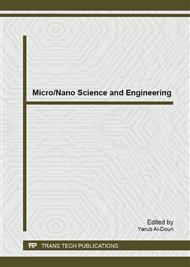p.92
p.96
p.101
p.105
p.110
p.115
p.120
p.125
p.130
Synthesis and Characterization of Zinc Oxide Nanostructures by Different Sonication Period
Abstract:
Zinc oxide (ZnO) is a wide band gap semiconductor material (3.37 eV) with numerous present applications such as varistors, surface acoustic wave devices and future biomedical applications. ZnO nanorods were grown under specific growth condition by an inexpensive and simple, chemical bath deposition method on ZnO seeded glass substrates. Study of the ZnO nanorods over different precursors, i.e zinc acetate dehydrate and zinc nitrate hexahydrate, and sonication period ranging from 0 to 120 seconds by field emission scanning electron microscope (FESEM), including the nanorod size and the surface morphology, will be demonstrated in this paper. Characterization of the ZnO film using both X-ray diffraction (XRD) and UV-Vis spectroscopy will be established in determining the optimal composition along with the optical properties, respectively.
Info:
Periodical:
Pages:
110-114
Citation:
Online since:
April 2014
Keywords:
Price:
Сopyright:
© 2014 Trans Tech Publications Ltd. All Rights Reserved
Share:
Citation:


